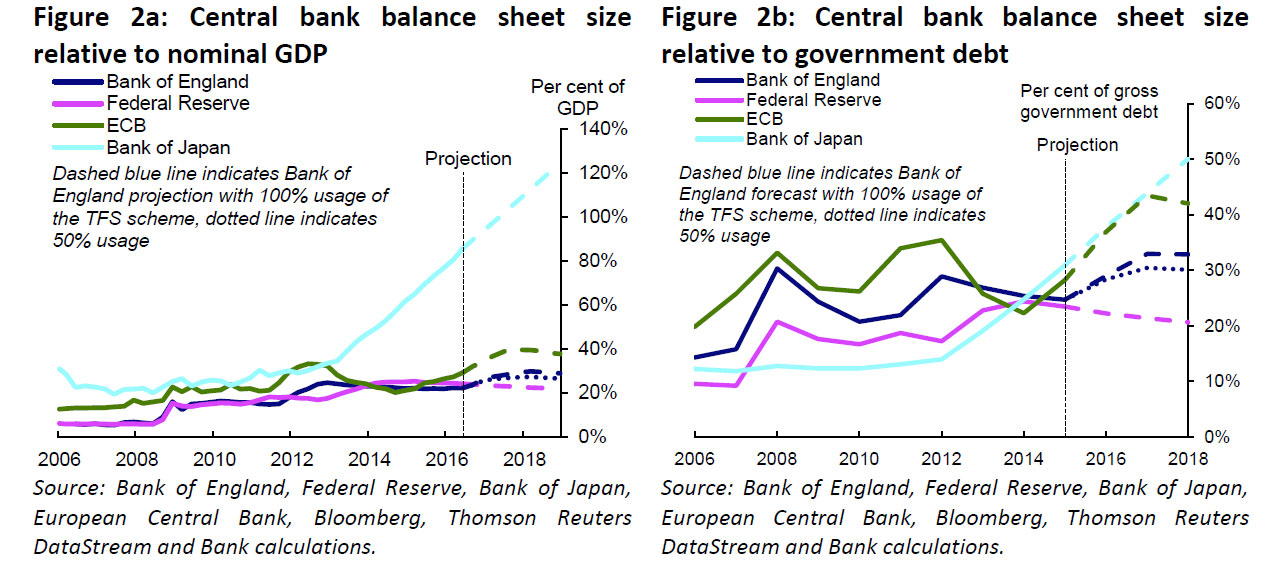A Bank of England staff working paper “QE: the story so far” looks at the impact of QE and reviews the impact of central bank balance sheet expansions on financial markets and the economy. QE has led to a massive expansion in central bank balance sheets. Their analysis identifies three significant impacts. First, it is only when central bank balance sheet expansions are used as a monetary policy tool that they have a significant macro-economic impact. Second, there is evidence for the US that the effectiveness of QE may vary over time, depending on the state of the economy and liquidity of the financial system. And third, QE can have strong spill-over effects cross-border, acting mainly via financial channels. For example, the impact of US QE on UK economic activity may be as large as the impact on US economic activity.
The modern history of Quantitative Easing (QE) starts in February 1999. With policy rates having approached the lower bound for nominal interest rates, one member of the Bank of Japan’s (BoJ’s) Policy Board expressed an opinion that the Bank of Japan should “implement a quantitative easing by targeting the monetary base”. In 2001, Japan began down that road, purchasing government bonds financed by the creation of central bank reserves.
Outside Japan, QE was first adopted by the US Federal Reserve and the Bank of England in 2008 and 2009, as they neared the lower bound for nominal interest rates and sought to provide additional monetary stimulus. In 2015, these countries were joined by the euro-area, as the European Central Bank (ECB) began expanding its balance sheet as it neared the lower bound for interest rates. Three of these four central banks were continuing to expand their balance sheets in the second half of
2016.Thus, it is only during this century, and in particular since the global financial crisis, that we have seen central bank balance sheet expansions taking on an explicit monetary policy objective. Since 2007-8, as a number of countries approached the effective lower bound for official interest rates, central banks made outright purchases of securities funded by the creation of central bank reserves – Quantitative Easing or QE. This has led to a substantial increase in central banks’ balance sheets, both relative to nominal GDP and to the stock of government debt outstanding.
 But what are the impacts of this approach?
But what are the impacts of this approach?
The first half of the paper reviews the international evidence on the impact on financial markets and economic activity of this policy. It finds that these central bank balance sheet expansions had a discernible and significant impact on financial markets and the economy.
The second half of the paper provides new empirical analysis on the macroeconomic impact of central bank balance sheet expansions, across time and countries.
They conclude “In the past decade or so, central bank balance sheet expansions have been used as a tool for loosening monetary policy. This paper has gathered together empirical evidence on the effectiveness of these policies on financial markets and the wider economy. It finds reasonably strong evidence of QE having had a material impact on financial markets, generating a significant loosening in credit conditions. There is also evidence of QE having served to boost temporarily output and prices, in a way not associated with other central bank balance sheet expansions.
The effectiveness of QE policies does vary, however, both across countries and time. For example, there is some evidence of QE interventions being more effective when financial markets are disturbed. There is also evidence of strong positive international spill-over effects of QE from one country to another. This paper has focussed on the aggregate impact of central bank balance sheet expansions. This leaves to future research important issues such as the impact of a reversal in QE policies and the distributional consequences of QE.
Note: The views expressed in this paper are those of the authors, and not necessarily those of the Bank of England or its committees.
